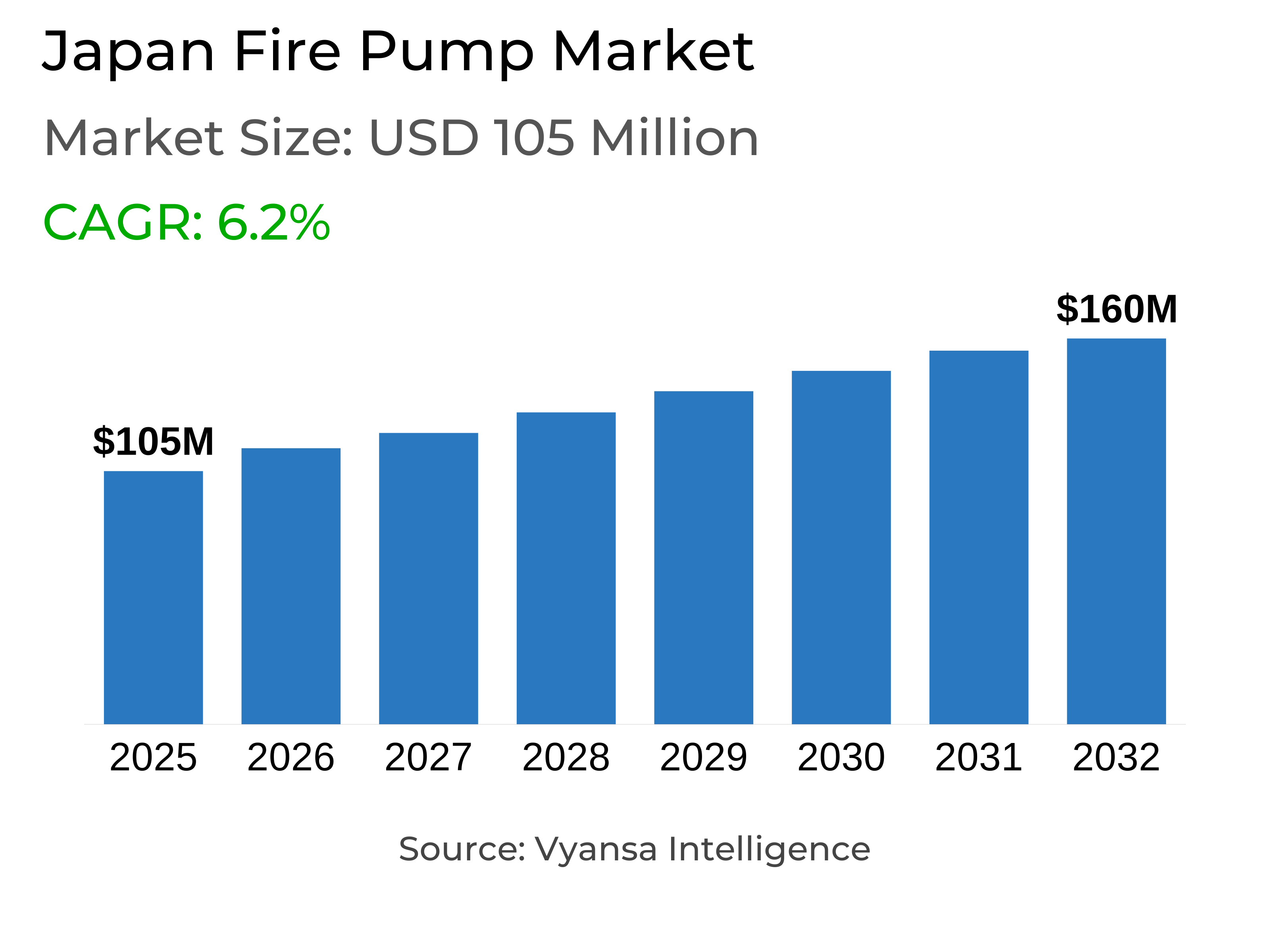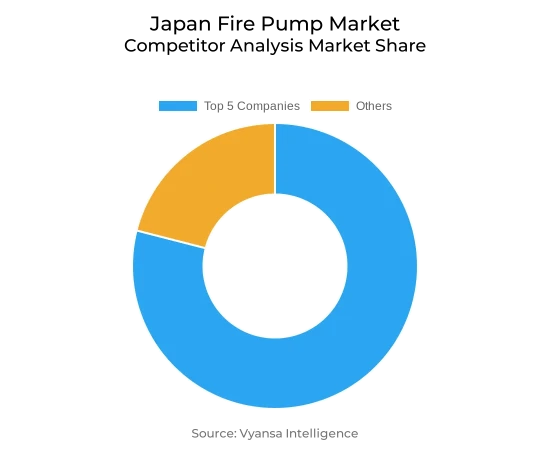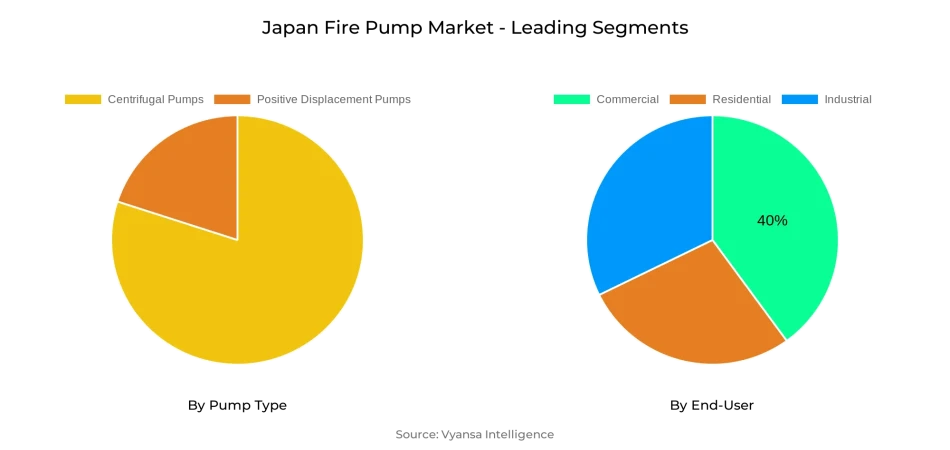
Japan Fire Pump Market Report: Trends, Growth and Forecast (2026-2032)
By Pump Type (Centrifugal Pumps (Overhung Pumps, Vertical Inline, Horizontal End Suction), Split Case Pumps (Single/Two Stage, Multi Stage)), Positive Displacement Pumps (Diaphragm Pumps, Piston Pumps), By Mode of Operation (Diesel Fire Pump, Electric Fire Pump, Others), By End-User (Residential, Commercial, Industrial)
- Energy & Power
- Oct 2025
- VI0505
- 125
-




Japan Fire Pump Market Statistics and Insights, 2026
- Market Size Statistics
- Fire Pump in Japan is estimated at $ 105 Million.
- The market size is expected to grow to $ 160 Million by 2032.
- Market to register a CAGR of around 6.2% during 2026-32.
- Pump Type Segment
- Centrifugal Pumps continues to dominate the market.
- Competition
- More than 10 companies are actively engaged in producing Fire Pump in Japan.
- Top 5 companies acquired the maximum share of the market.
- WILO SE, Ebara Corporation, ITT Goulds Pumps, Flowserve Corporation, Pentair PLC etc., are few of the top companies.
- End-User
- Commercial grabbed 40% of the market.
Japan Fire Pump Market Outlook
The Japan Fire Pump Market, at USD 105 million in 2025, is estimated to grow to USD 160 million by 2032. The growth is underpinned by Japan's robust emergency response system run by the Fire and Disaster Management Agency (FDMA), which functions through thousands of local fire brigades. Tight guidelines demanding pumps to achieve performance standards guarantee constant demand for efficient and dependable equipment, most notably centrifugal pumps, which predominate due to their high flow rate and simplicity in maintenance.
Yet the consistent decrease in fire incident numbers, with 36,314 reported in 2022—the lowest decade figure ever—is putting pressure on incident-led procurement. Fire brigades are prioritizing necessary upgrades over mass replacements, so it is now imperative for manufacturers to differentiate through next-generation technology. The incorporation of IoT-enabled monitoring and predictive maintenance functionalities enables pumps to fit into wider multi-hazard response programs and maintain relevance in the face of reduced emergency-led purchases.
Digitalization is becoming a general trend, as smart pumps and connected equipment allow real-time monitoring and asset optimization during emergencies. This digital transformation enhances operational efficiency, minimizes downtime, and presents new aftermarket business opportunities. Meanwhile, modernization initiatives such as replacement of old fire stations with new ones and implementation of hybrid systems backed up by diesel and battery are generating demand for energy-efficient and disaster-resilient solutions.
On the demand side, commercial end users are the largest segment with 40% of the market, and they have robust adoption in office buildings, shopping facilities, and hotels. In tandem with this, the residential segment is the most rapidly growing, fueled by increased awareness of fire safety and integration into smart homes. Combined, these forces demonstrate a stable core demand market while creating new avenues for growth through modernization and digital adaptation.

Japan Fire Pump Market Growth Driver
Strong Emergency Response Infrastructure
Japan has a well-coordinated emergency response system, centrally controlled by the Fire and Disaster Management Agency (FDMA). There are 4,600 certified Emergency Fire Response Teams in 770 local fire departments to ensure quick mobilization of pumps and specialized firefighting equipment in case of large-scale incidents. Technical standards are strictly regulated, whereby pumps must provide effective drainage in a maximum of five minutes and continue operation continuously despite repeated engine restarts, ensuring reliability throughout operations. This stringent regimen emphasizes the country's devotion to protecting both urban and rural zones with reliable fire suppression facilities.
Apart from policy, operational need drives constant equipment upgrading. In 2022 alone, Japan reported 36,314 fire cases, including 1,239 wildland fires, highlighting the value of reliable suppression systems. Local governments unfailingly prefer performance-tested pumps that achieve FDMA standards, fueling consistent demand for upgraded solutions. This strong institutional backing underpins long-term investment in advanced fire pumps and enhances their position as a pillar of emergency readiness.
Japan Fire Pump Market Challenge
Market Pressures from Declining Fire Incidents
Even with high preparedness, the total fire cases in Japan have been decreasing steadily, with 36,314 cases in 2022 being one of the lowest in a decade. This decline decreases incident-based procurement and reduces replacement cycles, imposing budgetary limitations on fire departments. Urban fires, specifically, are declining, directly impacting short-term demand for high-volume emergency pump procurement. Procurement priorities thus turn towards upgrading only necessary components, compelling manufacturers to adjust their strategies.
Suppliers are now confronted with the task of demarcating offerings within a market dominated by fewer urgency-driven purchases. Providing extra value beyond regulatory compliance is essential, as manufacturers increasingly integrate pumps into overall multi-hazard projects. Incorporating features like IoT-enabled monitoring or cross-functional emergency response capabilities aids in compensating for decreased dependency on incident-driven demand. Riding this wave necessitates pump makers positioning themselves as strategic partners rather than merely equipment providers, providing long-term resilience solutions for emerging safety paradigms.
Japan Fire Pump Market Trend
Rising Integration of Digital Technologies
Japan's firefighting services increasingly use digitalized pump technologies to enhance operational effectiveness. Sensor-based smart centrifugal pumps now allow remote monitoring of engine conditions, water pressure, and flow rates, reducing downtime and increasing predictive maintenance capability. This lowers operation costs and assists fire departments in staying ready for a variety of situations. Real-time dashboards provide dispatchers with the means to streamline resource allocation during emergencies, allowing for faster, data-driven responses.
The digital transition is also applied to networked command vehicles, with integrated pump diagnostics plugged into central systems. This improves situational awareness in incidents and provides insights for use in future risk analysis. By integrating pumps into broader data ecosystems, Japan's firefighting enhances resilience and responsiveness. These developments not only enhance frontline operations but also present new avenues for aftermarket services, software upgrades, and digital partnership with municipalities, consistently remodeling procurement trends in the Japan Fire Pump Market.
Japan Fire Pump Market Opportunity
Expanding Scope of Modernization Projects
Aging fire stations throughout Japan pose substantial modernization needs, providing steady demand for pump makers. Government grants to support upgrading infrastructure promote local governments to phase out old equipment with pumps that satisfy the FDMA's changing technical requirements. Retrofit programs prefer energy-efficient engines and modular centrifugal pump units that streamline maintenance and reduce replacement costs while allowing compliance with revised safety regulations. This leaves space for innovation in product development and lifecycle service support.
More options come through hybrid pump systems that integrate diesel engines and backup battery units. The configurations give them resiliency during seismic interruption or loss of power, the broader purpose of Japan's disaster-preparedness infrastructure approach. The focus on sustainable, high-tech equipment enhances supplier prospects to collaborate with both municipal agencies and volunteer fire departments. By framing solutions in terms of modernization and resilience, manufacturers can win long-term contracts, solidifying pump upgrades as a key part of Japan's safety infrastructure policy.
Japan Fire Pump Market Segmentation Analysis

By Pump Type
- Centrifugal Pumps
- Positive Displacement Pumps
Centrifugal pumps dominate the highest market share among Japan's fire pump market, due to their ease of design, large flow capacity, and proven adaptability across firefighting applications. Their capacity for providing effective water flow at fluctuating pressures places them irreplaceable in urban hydrant networks, rural facilities, and portable applications deployed far away from population centers. Volunteer groups and fire brigades persist in the use of centrifugal pumps because they are simple to use and maintain in a manner that satisfies their needs. This deep-rooted dependency consolidates their market leadership across the nation.
Manufacturers further enhance centrifugal pump technologies to address changing performance needs. Improvements in corrosion resistance, quiet operation, and energy efficiency are all direct responses to end-user input. The integration of stainless steel impellers and variable-frequency drives further enhances durability and energy efficiency. These ongoing improvements ensure that centrifugal pumps remain the first choice in Japan's fire suppression infrastructure, cementing the position as the most adopted pump type in the industry.
By End-User
- Residential
- Commercial
- Industrial
Commercial end users have the highest market share and occupy 40% of all fire pump installations in Japan. Office buildings, shopping centers, and multi-story hotels always need strong fire extinguishing systems, solidifying commercial properties as a key application segment. The concentration of individuals and investments in urban areas guarantees commercial developments will continue to be a robust catalyst for pump deployments. This stability underpins long-term demand from the business and services industry.
In addition to commercial applications, the residential market is fast becoming the highest-growing segment with a CAGR of 8.76%. Growing awareness of fire hazards, combined with widespread adoption of smart home automation systems, fuels uptake of low-noise, compact pumps appropriate for apartments and single-family homes. This two-way dynamic illustrates diversified growth through end users since commercial installations have a dominance of market share while residential use presents good potential for growth, transforming future patterns of demand in the Japan Fire Pump Market.
Top Companies in Japan Fire Pump Market
The top companies operating in the market include WILO SE, Ebara Corporation, ITT Goulds Pumps, Flowserve Corporation, Pentair PLC, Sulzer Limited, Grundfos Holding A/S, KSB SE & Co. KGaA, Patterson (Gorman Rupp), Armstrong, etc., are the top players operating in the Japan Fire Pump Market.
Frequently Asked Questions
Related Report
1. Market Segmentation
1.1. Research Scope
1.2. Research Methodology
1.3. Definitions and Assumptions
2. Executive Summary
3. Japan Fire Pump Market Policies, Regulations, and Standards
4. Japan Fire Pump Market Dynamics
4.1. Growth Factors
4.2. Challenges
4.3. Trends
4.4. Opportunities
5. Japan Fire Pump Market Statistics, 2022-2032F
5.1. Market Size & Growth Outlook
5.1.1.By Revenues in US$ Million
5.2. Market Segmentation & Growth Outlook
5.2.1.By Pump Type
5.2.1.1. Centrifugal Pumps- Market Insights and Forecast 2022-2032, USD Million
5.2.1.1.1.1. Overhung Pumps- Market Insights and Forecast 2022-2032, USD Million
5.2.1.1.1.2. Vertical Inline- Market Insights and Forecast 2022-2032, USD Million
5.2.1.1.1.3. Horizontal End Suction- Market Insights and Forecast 2022-2032, USD Million
5.2.1.1.2. Split Case Pumps- Market Insights and Forecast 2022-2032, USD Million
5.2.1.1.2.1. Single/Two Stage- Market Insights and Forecast 2022-2032, USD Million
5.2.1.1.2.2. Multi Stage- Market Insights and Forecast 2022-2032, USD Million
5.2.1.2. Positive Displacement Pumps- Market Insights and Forecast 2022-2032, USD Million
5.2.1.2.1. Diaphragm Pumps- Market Insights and Forecast 2022-2032, USD Million
5.2.1.2.2. Piston Pumps - Market Insights and Forecast 2022-2032, USD Million
5.2.2.By Mode of Operation
5.2.2.1. Diesel Fire Pump- Market Insights and Forecast 2022-2032, USD Million
5.2.2.2. Electric Fire Pump- Market Insights and Forecast 2022-2032, USD Million
5.2.2.3. Others- Market Insights and Forecast 2022-2032, USD Million
5.2.3.By End-User
5.2.3.1. Residential- Market Insights and Forecast 2022-2032, USD Million
5.2.3.2. Commercial- Market Insights and Forecast 2022-2032, USD Million
5.2.3.3. Industrial- Market Insights and Forecast 2022-2032, USD Million
5.2.4.By Competitors
5.2.4.1. Competition Characteristics
5.2.4.2. Market Share & Analysis
6. Japan Centrifugal Fire Pump Market Statistics, 2020-2030F
6.1. Market Size & Growth Outlook
6.1.1.By Revenues in US$ Million
6.2. Market Segmentation & Growth Outlook
6.2.1.By Pump Type- Market Insights and Forecast 2022-2032, USD Million
6.2.2.By Mode of Operation- Market Insights and Forecast 2022-2032, USD Million
6.2.3.By End-User- Market Insights and Forecast 2022-2032, USD Million
7. Japan Positive Displacement Fire Pump Market Statistics, 2020-2030F
7.1. Market Size & Growth Outlook
7.1.1.By Revenues in US$ Million
7.2. Market Segmentation & Growth Outlook
7.2.1.By Pump Type- Market Insights and Forecast 2022-2032, USD Million
7.2.2.By Mode of Operation- Market Insights and Forecast 2022-2032, USD Million
7.2.3.By End-User- Market Insights and Forecast 2022-2032, USD Million
8. Competitive Outlook
8.1. Company Profiles
8.1.1.Flowserve Corporation
8.1.1.1. Business Description
8.1.1.2. Product Portfolio
8.1.1.3. Collaborations & Alliances
8.1.1.4. Recent Developments
8.1.1.5. Financial Details
8.1.1.6. Others
8.1.2.Pentair PLC
8.1.2.1. Business Description
8.1.2.2. Product Portfolio
8.1.2.3. Collaborations & Alliances
8.1.2.4. Recent Developments
8.1.2.5. Financial Details
8.1.2.6. Others
8.1.3.Sulzer Limited
8.1.3.1. Business Description
8.1.3.2. Product Portfolio
8.1.3.3. Collaborations & Alliances
8.1.3.4. Recent Developments
8.1.3.5. Financial Details
8.1.3.6. Others
8.1.4.Grundfos Holding A/S
8.1.4.1. Business Description
8.1.4.2. Product Portfolio
8.1.4.3. Collaborations & Alliances
8.1.4.4. Recent Developments
8.1.4.5. Financial Details
8.1.4.6. Others
8.1.5.KSB SE & Co. KGaA
8.1.5.1. Business Description
8.1.5.2. Product Portfolio
8.1.5.3. Collaborations & Alliances
8.1.5.4. Recent Developments
8.1.5.5. Financial Details
8.1.5.6. Others
8.1.6.WILO SE
8.1.6.1. Business Description
8.1.6.2. Product Portfolio
8.1.6.3. Collaborations & Alliances
8.1.6.4. Recent Developments
8.1.6.5. Financial Details
8.1.6.6. Others
8.1.7.Ebara Corporation
8.1.7.1. Business Description
8.1.7.2. Product Portfolio
8.1.7.3. Collaborations & Alliances
8.1.7.4. Recent Developments
8.1.7.5. Financial Details
8.1.7.6. Others
8.1.8.ITT Goulds Pumps
8.1.8.1. Business Description
8.1.8.2. Product Portfolio
8.1.8.3. Collaborations & Alliances
8.1.8.4. Recent Developments
8.1.8.5. Financial Details
8.1.8.6. Others
8.1.9.Patterson (Gorman Rupp)
8.1.9.1. Business Description
8.1.9.2. Product Portfolio
8.1.9.3. Collaborations & Alliances
8.1.9.4. Recent Developments
8.1.9.5. Financial Details
8.1.9.6. Others
8.1.10. Armstrong
8.1.10.1. Business Description
8.1.10.2. Product Portfolio
8.1.10.3. Collaborations & Alliances
8.1.10.4. Recent Developments
8.1.10.5. Financial Details
8.1.10.6. Others
9. Disclaimer
| Segment | Sub-Segment |
|---|---|
| By Pump Type |
|
| By Mode of Operation |
|
| By End-User |
|
Research Methodology
This study followed a structured approach comprising four key phases to assess the size and scope of the electro-oxidation market. The process began with thorough secondary research to collect data on the target market, related markets, and broader industry context. These findings, along with preliminary assumptions and estimates, were then validated through extensive primary research involving industry experts from across the value chain. To calculate the overall market size, both top-down and bottom-up methodologies were employed. Finally, market segmentation and data triangulation techniques were applied to refine and validate segment-level estimations.
Secondary Research
The secondary research phase involved gathering data from a wide range of credible and published sources. This step helped in identifying industry trends, defining market segmentation, and understanding the market landscape and value chain.
Sources consulted during this phase included:
- Company annual reports, investor presentations, and press releases
- Industry white papers and certified publications
- Trade directories and market-recognized databases
- Articles from authoritative authors and reputable journals
- Gold and silver standard websites
Secondary research was critical in mapping out the industry's value chain and monetary flow, identifying key market segments, understanding regional variations, and tracking significant industry developments.
Other key sources:
- Financial disclosures
- Industry associations and trade bodies
- News outlets and business magazines
- Academic journals and research studies
- Paid industry databases
Primary Research
To validate secondary data and gain deeper market insights, primary research was conducted with key stakeholders across both the supply and demand sides of the market.
On the demand side, participants included decision-makers and influencers from end-user industries—such as CIOs, CTOs, and CSOs—who provided first-hand perspectives on market needs, product usage, and future expectations.
On the supply side, interviews were conducted with manufacturers, industry associations, and institutional participants to gather insights into current offerings, product pipelines, and market challenges.
Primary interviews provided critical inputs such as:
- Market size and revenue data
- Product and service breakdowns
- Market forecasts
- Regional and application-specific trends
Stakeholders consulted included:
- Leading OEM and solution providers
- Channel and distribution partners
- End users across various applications
- Independent consultants and industry specialists
Market Size Estimation and Data Triangulation
- Identifying Key Market Participants (Secondary Research)
- Goal: To identify the major players or companies in the target market. This typically involves using publicly available data sources such as industry reports, market research publications, and financial statements of companies.
- Tools: Reports from firms like Gartner, Forrester, Euromonitor, Statista, IBISWorld, and others. Public financial statements, news articles, and press releases from top market players.
- Extracting Earnings of Key Market Participants
- Goal: To estimate the earnings generated from the product or service being analyzed. This step helps in understanding the revenue potential of each market player in a specific geography.
- Methods: Earnings data can be gathered from:
- Publicly available financial reports (for listed companies).
- Interviews and primary data sources from professionals, such as Directors, VPs, SVPs, etc. This is especially useful for understanding more nuanced, internal data that isn't publicly disclosed.
- Annual reports and investor presentations of key players.
- Data Collation and Development of a Relevant Data Model
- Goal: To collate inputs from both primary and secondary sources into a structured, data-driven model for market estimation. This model will incorporate key market KPIs and any independent variables relevant to the market.
- Key KPIs: These could include:
- Market size, growth rate, and demand drivers.
- Industry-specific metrics like market share, average revenue per customer (ARPC), or average deal size.
- External variables, such as economic growth rates, inflation rates, or commodity prices, that could affect the market.
- Data Modeling: Based on this data, the market forecasts are developed for the next 5 years. A combination of trend analysis, scenario modeling, and statistical regression might be used to generate projections.
- Scenario Analysis
- Goal: To test different assumptions and validate how sensitive the market is to changes in key variables (e.g., market demand, regulatory changes, technological disruptions).
- Types of Scenarios:
- Base Case: Based on current assumptions and historical data.
- Best-Case Scenario: Assuming favorable market conditions, regulatory environments, and technological advancements.
- Worst-Case Scenario: Accounting for adverse factors, such as economic downturns, stricter regulations, or unexpected disruptions.
Partnering With Industry Leaders to Drive Growth
Our mission is to deliver intelligence that matters. By combining data, analysis, and industry expertise, we enable organizations to make smarter, faster, and more impactful decisions. Whether it’s a Fortune 500 company or a high-growth startup, businesses trust us to provide clarity in an ever-evolving marketplace.






